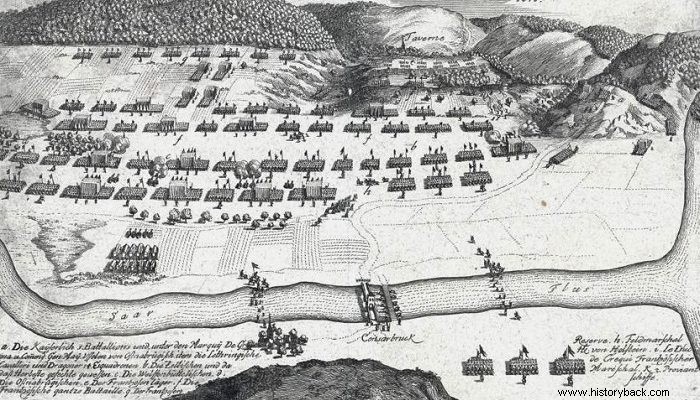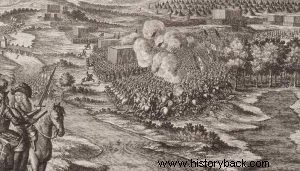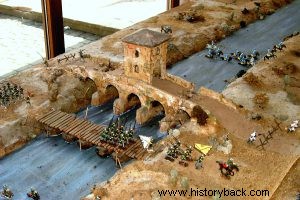
In 1675 the war that had started in 1672 as a military campaign of the then European superpower against the small Netherlands had changed course. The Dutch War which started as a limited scale conflict had developed into a pan-European war involving both the Habsburg Empire and the Holy Roman Empire of the German Nation (Reich).
On the 27th of July the German army under the excellent Marshal Montecucoli met the French at Zachbach. Yet one cannon shot was enough to decide the conflict as it tore to pieces the French leader, Grand Marshal Turenne. Without their leader the French army retreated in pursuit. Thus another German army under the duke of Lorraine Charles IV besieged the city of Trier which had been captured by the French in 1673.
There were seven French battalions in the city. The French king Louis XIV, however, wanted to preserve the city and thus sent the marshal François de Crequy to "break" the siege. Kreki had 12 battalions of infantry, 36 regiments of cavalry and 11 artillery (15,000 men in total). The Germans were informed of Kreki's approach and hastened to confront him, leaving 9 battalions and 4 islands to guard the besieged Trier.
The force that moved against Kreki numbered 11 battalions, 42 guns and 14 guns. The majority of Charles' force consisted of soldiers from the states of Lüneburg and Osnabruck. The others were from Lorraine, Münster, Trier and Austria. The German army formed three phalanxes. The right under the Austrian general von Grana had 12 Lorraine cavalry islands and 4 dragoon islands (2 Austrian, 2 Lorraine).
The central phalanx consisted of all infantry and artillery, while the left phalanx consisted of 24 cavalry (18 from Osnabruck and Lüneburg and 6 Austrian). The German army arrived on the evening of August 10 at the Koncher bridge on the river Saar (a tributary of the Moselle) and having easily subdued her French guards and brought her under control. The Germans had 16,000 men.
The next morning the Germans crossed the river at three points. The French were so taken by surprise that they let two of their riverboats carrying supplies be taken over by the German cavalry! Around 11.00 in the morning the Germans attacked. However the French fought superbly and held them.
Kreki even launched a counter-attack and almost destroyed the opposing faction. The situation was saved by the Austrian (of Italian origin) von Grana who gathered 2,200 cavalry, 600 dragoons, 4,500 infantry and 3 guns and charged against the French forcing the French left flank to retreat. The Germans captured the Tavern heights, flanking the remaining French forces.
Creki tried to save the day but soon his men fled in disorder. Of his men 2,000 were killed, 1,600 captured and thousands threw down their arms and deserted. All 11 French cannons, 80 flags and banners, as well as 200 carriages with supplies and ammunition fell into the hands of the victors. The victors had 1,000 dead.
The Germans pursued their defeated opponents at a distance of 50 km According to the descriptions, the Germans did not spare their opponents and there were French battalions that were completely annihilated. Kreki was miraculously saved and wearing the uniform of a Lorraine cavalryman managed to reach Trier taking the lead of the guard. The Germans returned to the siege. The French garrison resisted, but suffered terrible losses (out of 6,000 men only 1,500 remained). When Kreki refused a German offer to surrender the city, his men mutinied and surrendered. In the siege the Germans lost only 500 men.
Trier became German again and its ruler Bishop Karl Caspar von der Leyen. Kreki, however, continued the resistance, fortified with his few men in the cathedral of the city. Finally, however, the resistance of the French collapsed and Crequi was captured. The battle is a turning point in European history, although it remains generally unknown. It was the first major defeat of the forces of the French King Louis XIV, the "Sun King", which showed that the French army was not invincible. Of course it is not a catalytic conflict like that of Blenheim in 1704, but it did the most to turn the situation around at that time.


The Germans cross the Saar River.
